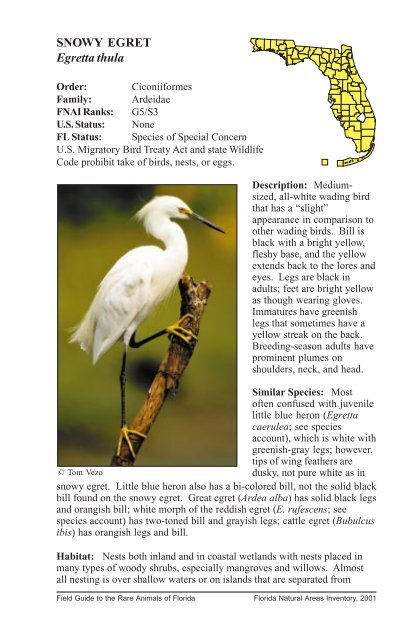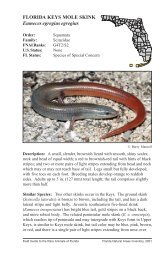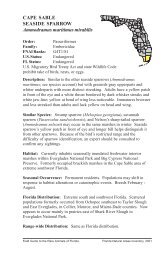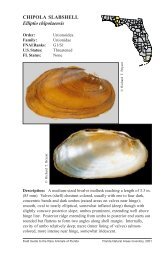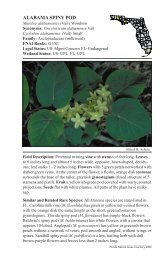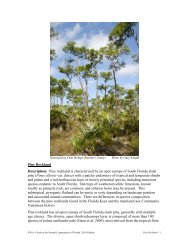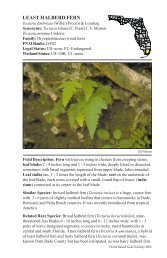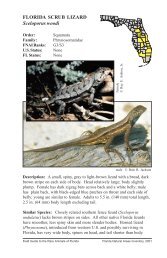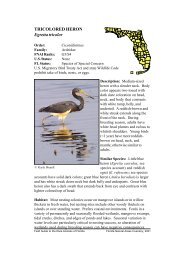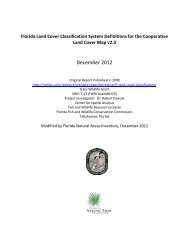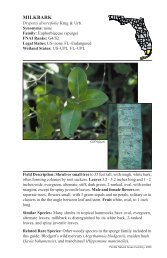SNOWY EGRET Egretta thula - FNAI - Florida Natural Areas Inventory
SNOWY EGRET Egretta thula - FNAI - Florida Natural Areas Inventory
SNOWY EGRET Egretta thula - FNAI - Florida Natural Areas Inventory
You also want an ePaper? Increase the reach of your titles
YUMPU automatically turns print PDFs into web optimized ePapers that Google loves.
<strong>SNOWY</strong> <strong>EGRET</strong><br />
<strong>Egretta</strong> <strong>thula</strong><br />
Order: Ciconiiformes<br />
Family: Ardeidae<br />
<strong>FNAI</strong> Ranks: G5/S3<br />
U.S. Status: None<br />
FL Status: Species of Special Concern<br />
U.S. Migratory Bird Treaty Act and state Wildlife<br />
Code prohibit take of birds, nests, or eggs.<br />
Description: Mediumsized,<br />
all-white wading bird<br />
that has a “slight”<br />
appearance in comparison to<br />
other wading birds. Bill is<br />
black with a bright yellow,<br />
fleshy base, and the yellow<br />
extends back to the lores and<br />
eyes. Legs are black in<br />
adults; feet are bright yellow<br />
as though wearing gloves.<br />
Immatures have greenish<br />
legs that sometimes have a<br />
yellow streak on the back.<br />
Breeding-season adults have<br />
prominent plumes on<br />
shoulders, neck, and head.<br />
Similar Species: Most<br />
often confused with juvenile<br />
little blue heron (<strong>Egretta</strong><br />
caerulea; see species<br />
account), which is white with<br />
greenish-gray legs; however,<br />
tips of wing feathers are<br />
© Tom Vezo<br />
dusky, not pure white as in<br />
snowy egret. Little blue heron also has a bi-colored bill, not the solid black<br />
bill found on the snowy egret. Great egret (Ardea alba) has solid black legs<br />
and orangish bill; white morph of the reddish egret (E. rufescens; see<br />
species account) has two-toned bill and grayish legs; cattle egret (Bubulcus<br />
ibis) has orangish legs and bill.<br />
Habitat: Nests both inland and in coastal wetlands with nests placed in<br />
many types of woody shrubs, especially mangroves and willows. Almost<br />
all nesting is over shallow waters or on islands that are separated from<br />
Field Guide to the Rare Animals of <strong>Florida</strong> <strong>Florida</strong> <strong>Natural</strong> <strong>Areas</strong> <strong>Inventory</strong>, 2001
<strong>SNOWY</strong> <strong>EGRET</strong><br />
<strong>Egretta</strong> <strong>thula</strong><br />
shoreline by extensive open water. Feeds in many types of permanently<br />
and seasonally flooded wetlands, streams, lakes, and swamps, and in manmade<br />
impoundments and ditches. Usually prefers calm waters. A wide<br />
variety of wetland types must be available within 5 - 7 mi. (8 - 11 km) to<br />
support breeding colonies. Breeding success is tied to water-level<br />
fluctuations.<br />
Seasonal Occurrence: Occurs in <strong>Florida</strong> in all seasons, but generally less<br />
common in winter, especially in western panhandle and northern counties.<br />
<strong>Florida</strong> Distribution: Generally found throughout peninsular <strong>Florida</strong>;<br />
becoming less common inland in northern tier of counties (north of<br />
Alachua County) and in the western panhandle. Typically more common<br />
along coast throughout its range. Breeding documented for 43 <strong>Florida</strong><br />
counties but more variable in western <strong>Florida</strong> panhandle and in some<br />
northern counties in the interior (north of Alachua County). Also rare or<br />
absent in southern Keys.<br />
Range-wide Distribution: Northern limits of summer range extend from<br />
northern California to southern Montana, central Kansas, and Tennessee,<br />
east to Atlantic coast, and then north to coastal Maine; occurs south to<br />
southern Chile and central Argentina; winters in North America from<br />
northern California to Arizona, along the northern Gulf coast, and along<br />
Atlantic coast to South Carolina.<br />
Conservation Status: Since the 1950s, numbers in <strong>Florida</strong> have been<br />
declining, possibly faster than declines of other herons and egrets. In 1989,<br />
this species was found in only 22 percent of the colonies where it formerly<br />
occurred. Persistent patterns of wetland destruction and alteration are<br />
probably eliminating large areas of essential habitat. Most impacts appear<br />
to affect quality of foraging habitat rather than areas immediately<br />
surrounding nesting colonies.<br />
Protection and Management: Prevent rapid changes in water depth in<br />
managed wetlands that will likely adversely affect quality of foraging.<br />
Restore and maintain natural hydroperiods in degraded wetland areas.<br />
Protect breeding and foraging habitats through establishment of preserves<br />
and regulation of wetlands. The <strong>Florida</strong> Fish and Wildlife Conservation<br />
Commission and the Department of Environmental Protection have<br />
developed setback distances around wading bird colonies of 330 ft. (100<br />
m) to prevent human disturbance.<br />
Selected References: Poole and Gill (eds.) 2000, Robertson and<br />
Woolfenden 1992, Rodgers and Smith 1995, Rodgers et al. (eds.) 1996,<br />
Runde et al. 1991, Stevenson and Anderson 1994.<br />
Field Guide to the Rare Animals of <strong>Florida</strong> <strong>Florida</strong> <strong>Natural</strong> <strong>Areas</strong> <strong>Inventory</strong>, 2001


